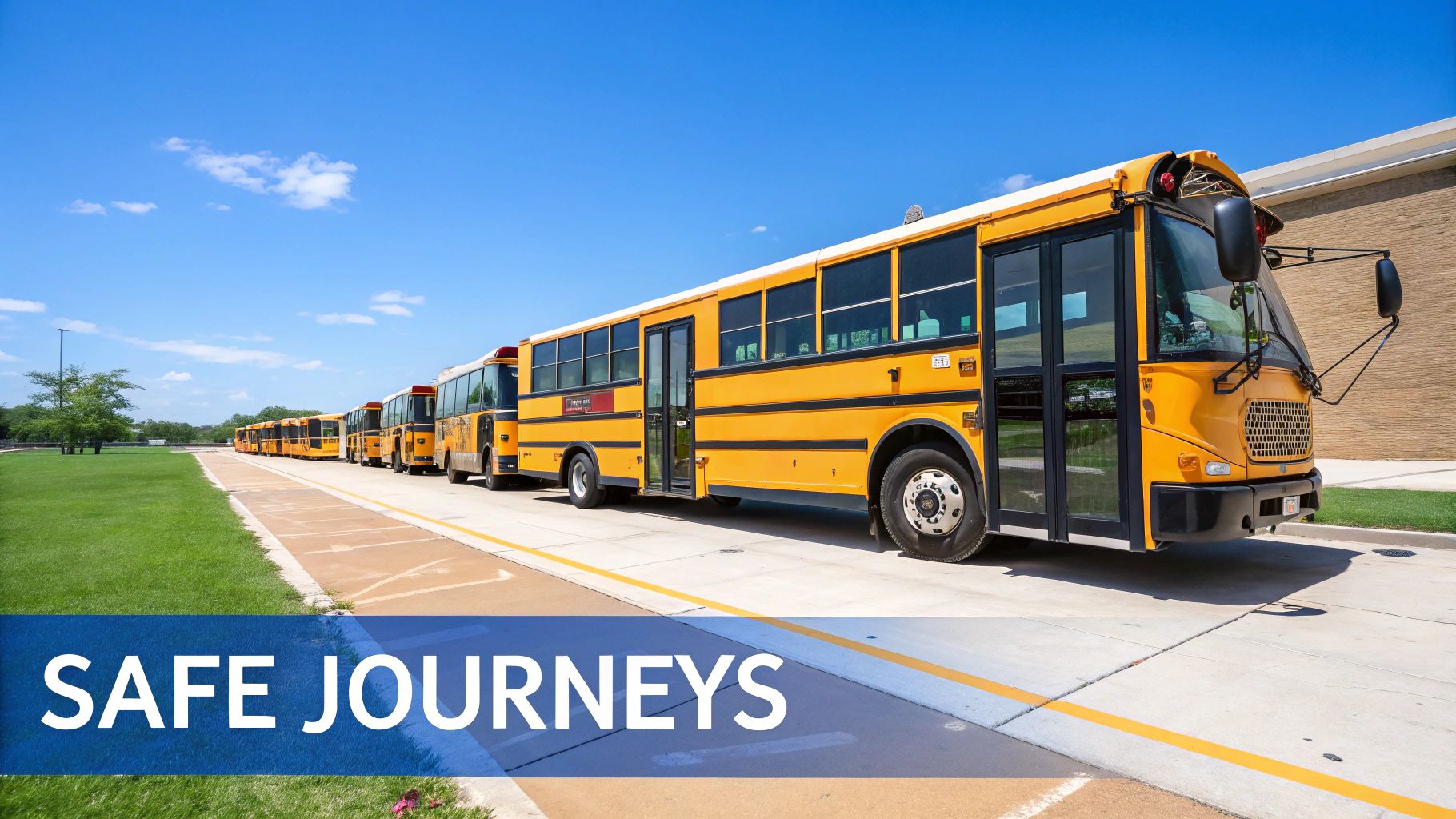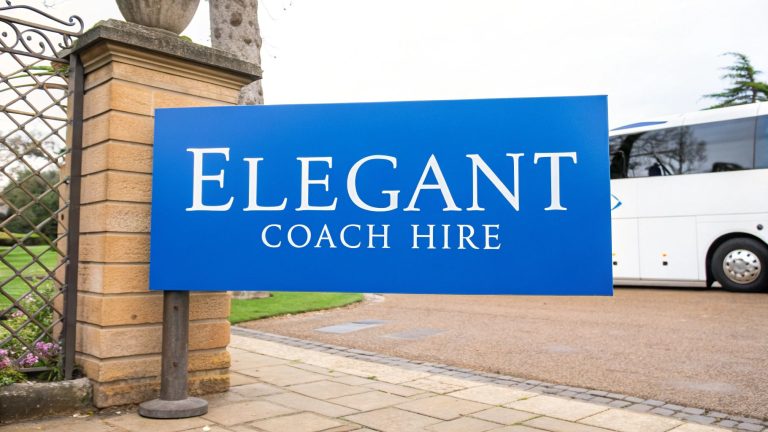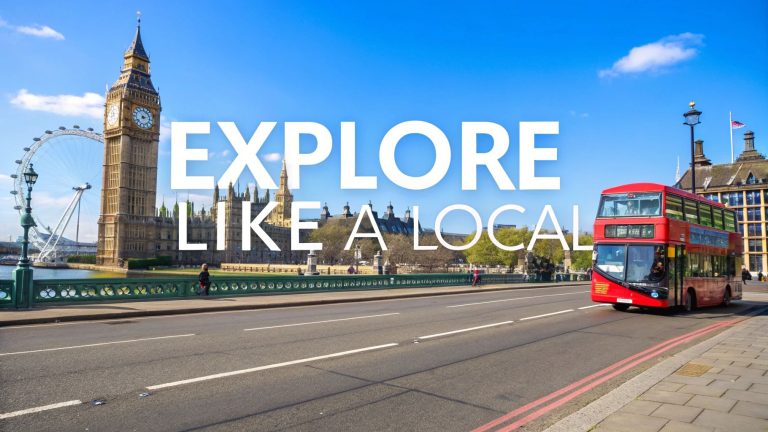Understanding Modern School Transportation Challenges
Schools face a daily puzzle when managing student transportation. Beyond regular school runs, there's a constant flow of sports events, field trips, and after-school activities to coordinate. Each activity brings its own requirements – from small buses for daily routes to larger coaches for whole-grade excursions. Getting everyone where they need to be safely and on time requires careful planning and the right mix of vehicles.
Evaluating Capacity and Fluctuations
Matching vehicle capacity to actual needs is a critical first step. Schools must avoid both overcrowded buses that compromise safety and underused vehicles that waste resources. This means regularly checking student numbers and planning for both expected changes (like new enrollments) and unexpected ones (like weather cancellations or schedule shifts). Having flexible transportation options helps schools adapt quickly when plans change.
Building a Flexible Transportation Plan
Good transportation planning requires three key elements: detailed scheduling, strong partnerships with bus companies, and clear communication with families. Take a multi-day sports tournament, for example – schools need to coordinate not just for their own teams but also arrange transport for visiting athletes. This is where having a reliable coach hire partner becomes essential for smooth operations.
Balancing Safety, Efficiency, and Budget
While student safety always comes first, schools also need to manage costs carefully. This often means comparing different bus companies, working out favorable long-term contracts, and creating efficient routes. A smart approach balances these competing needs without cutting corners on safety. For instance, when planning a museum trip, schools might choose a slightly pricier bus service that offers better safety features and experienced drivers.
The Importance of Reliable Coach Hire
Good transportation opens doors for students to fully participate in school life. Whether it's getting to class each morning or heading to a special event, dependable buses and coaches help make these experiences possible. By working with quality transportation providers, schools create a solid foundation that supports both everyday learning and memorable educational experiences beyond the classroom.
Mastering Safety Standards in Educational Transport

School transportation safety isn't just about following rules – it's about creating an environment where every student's wellbeing comes first. This means setting clear guidelines for everything from basic vehicle upkeep to driver requirements. Regular checks and reviews help ensure these safety measures stay effective over time.
Essential Safety Protocols for Coach Hire
Keeping students safe during transport takes a coordinated effort on multiple fronts. The foundation starts with careful vehicle maintenance and qualified drivers. A coach company must check every vehicle thoroughly and only work with drivers who have proper licenses, clean records, and solid experience.
Here are the key elements of a strong safety program:
- Vehicle Maintenance: Regular checks of brakes, tires, lights and other critical parts on a set schedule
- Driver Requirements: Complete background screening, driving history review, and verification of all needed certifications
- Emergency Plans: Clear steps for handling accidents, breakdowns, and medical issues, with regular practice drills
Implementing Comprehensive Safety Audits
Regular safety reviews provide an extra layer of protection and accountability. These checks should look at everything – from how well-maintained the vehicles are to how drivers perform their duties to whether safety rules are being followed. The findings help spot areas that need improvement while showing parents and schools that safety truly matters.
Building a Culture of Safety
Making safety a priority means getting everyone involved – drivers, school staff, and parents all play important roles. Open communication helps identify and address potential issues quickly. Ongoing training for drivers and staff reinforces good safety practices.
Recent data shows growing attention to professional training in student transport. 83-90% of coaches received formal training in 2023, up significantly from 51-66% in 2018. Parent concerns also highlight this focus – 80% believe there aren't enough qualified coaches, while 94% want background checks done. For more details, see: Learn more about coaching trends.
Choosing the Right Coach Hire Partner: A Focus on Safety
When picking a transport company for your school, safety must be the top priority. Look for providers like Brit Bus Travel that go beyond basic requirements. Key signs of a safety-focused company include a strong track record, clear communication, and proactive vehicle maintenance. Taking time to choose carefully helps create the safest possible environment for students while giving parents peace of mind.
Selecting Transportation Partners That Deliver Results
Finding the right coach hire for schools requires focusing on quality and student wellbeing, not just cost. A thorough evaluation process helps identify partners who will meet your school's specific transportation needs while maintaining the highest safety standards.
Establishing Your Evaluation Framework
Before reviewing potential providers, create a structured assessment approach focused on four essential areas: service reliability, fleet quality, customer support, and safety record. Each area needs specific measurement criteria – for example, tracking provider response times and analyzing their solutions for unexpected schedule changes. This framework helps ensure you evaluate all providers consistently and thoroughly.
Key Metrics for Assessing Service Reliability
Look at concrete performance data when evaluating reliability. This includes reviewing the provider's on-time arrival rate, driver qualifications and experience, and vehicle maintenance schedules. Good providers maintain detailed records showing consistent punctuality and professional driver conduct. Regular vehicle maintenance checks also indicate their commitment to preventing breakdowns and delays.
Evaluating Fleet Quality and Safety Standards
A quality fleet directly impacts student comfort and safety during trips. Check the age of each vehicle, inspect available comfort features, and verify their safety certification records. Modern coaches should have working air conditioning, properly maintained seatbelts, and current safety inspections. Ask providers to share their maintenance logs and safety certificates to confirm they meet required standards.
The Importance of Excellent Customer Support
Quick and clear communication makes a big difference in service quality. Test each provider's response time, support availability, and problem-solving abilities. Quality providers respond promptly to questions and have clear processes for handling both routine needs and urgent situations. This becomes especially important when dealing with weather delays or last-minute changes.
Data analysis helps schools make smarter choices about transportation services. Learn more about using data to evaluate providers in this guide on analytics in coach hiring decisions.
Negotiating Service Agreements That Protect Your School
Take time to review service contracts carefully before signing. Make sure agreements clearly spell out costs, payment schedules, cancellation rules, and insurance details. Clear contracts help prevent misunderstandings and establish shared expectations. Working with experienced providers like Brit Bus Travel can make this process smoother thanks to their proven track record of meeting school transportation needs.
Strategic Budget Management for Transportation Excellence

Smart management of school transportation costs goes beyond just cutting expenses. The key is finding the right balance between costs and quality when arranging coach hire for schools. Many successful schools do this by carefully tracking their spending, finding smart ways to save money, and building strong relationships with transport providers.
Cost Analysis: Understanding Your Spending
The foundation of good budget management is knowing exactly where your money goes. Take time to break down all your transport costs into specific categories – from fuel and driver pay to vehicle upkeep and insurance costs. This detailed view helps spot unusual patterns, like higher maintenance costs for certain vehicles. For instance, if older buses need frequent repairs, it might be time to rethink your fleet mix.
Uncovering Hidden Savings Opportunities
After getting clear on your spending habits, look for creative ways to reduce costs. Could you save fuel by combining some bus routes? Is there room to get better deals on regular services like maintenance? The goal is finding savings that don't compromise service quality. The money you save can then go toward important upgrades like better safety features or additional driver training.
Negotiation: Securing the Best Value for Coach Hire
Getting good deals from coach companies takes skill and preparation. Instead of accepting the first price offered, do your homework. Compare different companies' prices and services, then use this information when discussing rates. For example, working with Brit Bus Travel on a long-term basis might cost less than using different providers throughout the year. Also, try to build some flexibility into your contracts to handle changing student numbers.
Building a Sustainable Transportation Budget
A practical transportation budget needs to work well both now and in the future. Keep track of your costs regularly, measure important things like whether buses run on time, and check if students are happy with the service. Make changes when needed to keep everything running smoothly. This careful attention helps ensure you're using your money wisely while providing reliable transportation for your students.
Optimizing Daily Transportation Operations

Running school transportation smoothly requires careful daily management. Success depends on having efficient routes, reliable communication systems, and clear emergency procedures in place. Let's explore practical ways schools can tackle common transportation challenges while keeping students safe and on schedule.
Advanced Route Optimization Techniques
Smart route planning makes a big difference in school transportation costs and reliability. The best routes account for real traffic patterns, convenient pickup spots, and student numbers on each bus. Modern planning software helps crunch these numbers to find the fastest, most fuel-efficient paths. It's also wise to build in some wiggle room for detours around road work or accidents.
Effective Communication Protocols
Good communication keeps everyone in the loop – from school staff to drivers to parents. Setting up a reliable notification system is essential for updating parents about delays or schedule changes. This could be through a simple app, text alerts, or automated calls. Quick communication between drivers and dispatchers also helps solve problems fast when they pop up.
Emergency Response Planning
When problems strike – like a broken-down bus or minor accident – quick action matters. A solid emergency plan spells out exactly what to do: who calls emergency services, how to notify parents, and where backup transportation will come from. Regular practice runs ensure everyone knows their role if trouble hits.
Handling Common Transportation Challenges
Bad weather and last-minute schedule changes are facts of life in school transportation. Smart schools prepare by mapping out backup routes for snow days and creating simple ways to spread the word about changes. Working with experienced coach services like Brit Bus Travel helps too – they've seen it all and know how to adapt when plans need changing.
Staff Training, Parent Communication, and Incident Management
Well-trained staff keep the wheels turning smoothly. Bus drivers need solid training in safety rules, navigation, and working with students. Office staff should know communication procedures cold. Regular updates to parents build trust and cooperation. Clear records of any incidents, from fender-benders to behavior issues, help improve safety and service over time.
Smart Technology Solutions for School Transportation

Schools need reliable transportation to get students safely to and from campus each day. Modern technology now makes it easier than ever to manage bus fleets efficiently and provide peace of mind to parents. From tracking vehicles in real-time to finding optimal routes, these tools help schools run smoother transportation operations for daily routes, field trips, and sporting events.
GPS Tracking for Better Visibility and Safety
GPS tracking gives schools and parents real-time information about where each bus is located. When a bus is running late or needs to change its route, administrators can quickly see its location and respond. For instance, if a bus breaks down, staff can immediately send help to the exact spot. This visibility helps keep students safe and gives parents confidence in the transportation system.
Smart Route Planning That Saves Time and Money
Planning efficient bus routes used to involve lots of manual work. Now, route planning software makes it simple by analyzing traffic patterns, pickup locations, and how many students each bus can carry. Just like using a navigation app to avoid traffic on your commute, these tools find the quickest paths for school buses. This means less time on the road and lower fuel costs.
Better Communication Between Schools and Parents
Good communication keeps everyone informed about transportation changes. Modern messaging systems let schools send instant updates about delays or schedule adjustments directly to parents' phones. Parents can also easily reach out with questions or concerns. This open line of communication builds trust and reduces stress around student transportation.
Choosing the Right Technology for Your School
When selecting transportation technology, focus on what works best for your specific situation. Here are key factors to consider:
- Room to grow: Pick systems that can handle more students and routes as needed
- Works together: Make sure new tools connect with your current school software
- Simple to use: Choose options that staff and parents can navigate easily
- Budget-friendly: Look at both upfront costs and long-term value
The right technology makes school transportation safer and more reliable for everyone involved – students, parents, administrators and drivers. When looking for coach services, consider providers like Brit Bus Travel who use modern tools to deliver better service.
Want to improve your school's transportation system? Contact Brit Bus Travel to learn about their school transportation services that put safety and efficiency first.






